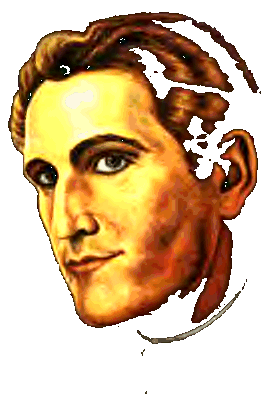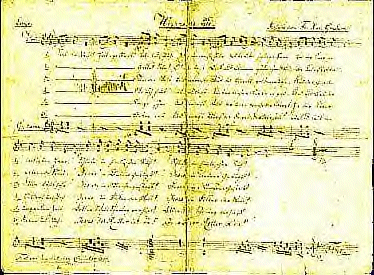

Silent Night,
The Mohr and Reifel Families




Eva Katharina Reifel married Jacob Luther Mohr in about 1835, probably in Bellheim or Hördt, in the Rhineland-Pfalz area of Germany near Heidelburg. They had 3 sons, born between 1836 and 1842, all born in Germany. In 1851 this family, along with many of their Reifel relatives, immigrated to America, settling in Peppertown, Indiana.
But as early as 1819, when Jacob was 21 and Eva only 7 years old, more and more Christmas celebrations began to include a beautiful new song. One year earlier, on December 24, 1818, a priest by the name of Joseph Mohr had written and performed what was to become perhaps the most beloved Christmas song of all time: Silent Night. As the fame of this song spread, hopeful rumors began to circulate among the Mohr and Reifel families that the priest Joseph Mohr might be a family relative.
Was the rumor true? We owe most of the details of the following account to Hr. Hanno Schilf, author of two books about Silent Night, and founder of the Stille Nacht Museum in Salzburg. [Be aware: Mr. Hanno has admitted to some "enhancing" of the retelling, but hopefully the vital facts remain true.]
Church in Mariapfarr
There was a Mohr family that lived in the high mountain valley village of Mariapfarr, not far from Salzburg. This family was forced to pay heavy death duties incurred during three successive tragic inheritances. The family had been forced to auction the Mohr family property for 500 florins, but it was still not enough. Family members found themselves almost homeless and totally bankrupt.
Franz Joseph Mohr, born in 1764 and by that time 28 years old, committed himself to 6 years of military service. Soldiers were relatively well-paid and could supplement their wages with night duty.
Franz Joseph's father moved from his birthplace of Mariapfarr to Stranach, a village which is a 30-minute walk to the south of Mariapfarr. Here he lived and worked on a farm estate 2 miles from Mariapfarr. He was also in charge of the bathhouse there and was widely known as a "healer" which was unusual in those days. Medicine was generally the domain of midwives and woman healers. Q: What was the name of Franz Joseph Mohr's father? What is known of his mother? Q: Did Franz Joseph have any brothers and sisters, and do any of them have descendants?
Franz Joseph Mohr was stationed in Salzburg in 1792 at the Steintor on a street called the Steingasse, and boarded nearby in a private apartment near the river Salzach. Whenever he could, he earned additional money by working at night as a watchman. His lodging was located on the Steingasse, at house Number 9 (or 31, or both at different times). Maria Schoiber rented these living quarters with her daughter, Anna.
Anna already had 2 daughters of her own, and in the winter her niece, Theresia, also lived with them. These 5 people, plus the soldier, had to take turns sleeping in two beds in a single room.
There was no heating in their room, and their landlord imposed strict rules for how often the tiny kitchen could be used. In the winter Anna heated large stones in the kitchen's hearth and carried them to an iron bowl in the living room to provide at least a little warmth for them.
The Schoiber family earned their meager living by spinning and knitting, but this did not provide enough for them to live on. This was why they had to take in a soldier from the nearby fortress as a lodger. In 1792, this soldier was 28-year-old Franz Joseph Mohr.
In addition to his duties as one of the archbishop's musketeers, soldier Mohr supplemented his income as a watchman at one of the Salzburg city gates. When he worked at night, this left him little time to sleep. In the wintertime he was entitled to a warm bed, even when he worked late into the night, which meant that someone had to stay under the covers and wait until morning for the soldier to arrive. We can only assume that on one cold March morning, Anna Schoiber got up too late, or the soldier got into bed too early!
Either way, nine months later on December 11, 1792, Joseph Mohr was born.
On hearing that Anna was expecting his child, soldier Mohr fled. He deserted the army, too. Little Joseph's mother was immediately punished. Anna already had two illegitimate children, so this was her third "carnal offense" and she was sentenced to pay a fine of 9 florins. This was as much as Anna earned in a whole year, but failure to pay would have meant incarceration in the workhouse.
Anna escaped from this terrible fate due to an unlikely benefactor, the Salzburg town executioner. Franz Joseph Wohlmuth had beheaded more than 80 people and had tortured confessions out of another 200. He was a despised and frightening figure. No one dared look him in the eye or make any physical contact with him. Being only human, this was painful and embarrassing to him.
Franz Joseph Wohlmuth was also rich, and seeking to improve his reputation, he offered to pay Anna Schoiber's 9-florin fine. In return, he wanted to be allowed to become the child's godfather. Having little choice in the matter, Anna accepted this gesture of benevolence, and after Joseph's birth, Wohlmuth quickly arranged for an elaborate cathedral christening. In the end Wohlmuth did not attend in person, but sent his cook, Franzika Zachim, instead. Apparently this was to avoid the embarrassment of not being allowed to lift the child out of the font in the traditional way.
For little Joseph Mohr, this was a socially crippling start to his childhood. Not only was he illegitimate, but he was also the executioner's godson. As such he was banned from going to school, from learning a trade, and he had no right to work. Having been born in the "Old Town" near the Cathedral (the Dom), the youngster grew up in another area of the city, the "New Town" across the Salzach River.
As a result of the circumstances of his birth, Joseph spent the early part of his childhood playing on the Salzach riverbank, watching the boatmen pass by on their barges and listening to them sing. Sometimes Joseph hitched a ride on one of the barges. Several miles downriver from Salzburg he would jump off again and walk back into town.
Another of his favorite childhood playgrounds was the Imbergsteige, the long line of steps that led from behind his house on the Steingasse, all the way up to the top of the hill, where the Capuchin monastery was located. On Sundays and holidays, these stairs were one of the favorite promenades of the people of Salzburg. By starting out from the Linzergasse one can walk up past all of the "stations of the cross" to the top of the Kapuzinerberg.
From the Kapuzinerberg hilltop there is a beautiful view out over the city and the fortress, with mountains in the background. The Imbergstiege led back down to the Steingasse, and it was here that young Joseph watched the finely dressed strollers, and perhaps they saw him entertaining himself.
One day a Benedictine monk, Johann Nepomuk Hiernle, was coming down these steps and happened to hear Joseph singing. As the cathedral choirmaster, the monk recognized some talent in Joseph. In fact, he was so enchanted by Joseph's voice that he immediately went with Joseph in search of the boy's mother.
When he found Anna, the monk told her that such musical talent had to be trained or it would go to waste. He left deeply moved by the story of Joseph's plight, and arranged for Joseph to attend the St. Peter Stift School, a Benedictine academic establishment of the elite located in Kremsmünster, Upper Austria. The school records show that Joseph was always among the best six in the class of 24 pupils. By 1804, at the age of 12, he has already mastered three instruments incredibly well: the guitar, the violin, and the organ. In 1808 he began to study philosophy, theology, rhetoric and music at the Benedictine University in Kremsmünster.
In 1811 Joseph's father, Franz Joseph Mohr, reappeared in Salzburg after an absence of 19 years. He was readmitted to military service without punishment, became watchman at the Klausentor, but died in 1814, only a few days after completing his original six years of service. Q: Where did he spend those 19 years, and did he father any additional children during that time?
In 1811 Joseph Mohr returned to Salzburg and was accepted as a scholarship student at the archdiocesan seminary where he completed his education and was ordained a priest on August 21, 1815.
Father Joseph Mohr
In 1815 his first assignment took him to Mariapfarr, located 80 miles south of Salzburg. It is on a high plateau called the Lungau. In the winter the snows cut Mariapfarr off from the rest of the world until spring. Joseph was going to live in the village that had been home to his father, the soldier he had never met.
When he arrived in Mariapfarr, Joseph Mohr was met by Father Joseph Stoff who took him to the large parsonage. Besides Joseph, there were two other assistant priests working in the pilgrim church. A few days later, Stoff took Joseph to meet his grandfather who lived and worked on a farm estate in nearby Stranach. Grandfather Mohr was 86 years old, a very rare age to reach in those days. He was known as a "healer" and his age was itself the best evidence of the effectiveness of his herbs, infusions and tinctures.
Joseph was deeply impressed by the unusual worship practices of the church and people in Mariapfarr, where they spoke and sang in German, and music was performed not just on the organ, but also was played on flutes and violins.
In the beginning of the new year, 1817, Grandfather Mohr died. Joseph buried him himself. He had known his grandfather only four months.
During his service in the Alpine village, Joseph wrote a poem, "Stille Nacht! Heilige Nacht!" Due to poor health, he was sent back to Salzburg for hospitalization and when he recovered, in 1817 he was assigned as assistant pastor to St. Nicholas Church in Oberndorf. It was hoped that the milder climate in Oberndorf would be healthier for him.
It was in Oberndorf that Joseph met and became friends with the Arnsdorf schoolmaster and church verger, Franz Xaver Gruber, who also served as organist at St. Nicholas. On Christmas eve, 1818, Father Joseph Mohr took a 20-minute walk to Arnsdorf with a copy of the poem he had written in 1816, to visit Franz Gruber and ask a favor of him.
Father Mohr loved to play the guitar, and he wanted a Christmas song in the German language that he could sing while playing his guitar. Franz Gruber wrote the music, and in the style of Mariapfarr services, the song was sung that evening for the first time at Midnight Mass in Oberndorf.
In 1819 Father Mohr was transferred from Oberndorf, and sometime between then and 1821 he wrote out an arrangement of the carol. This document was discovered in 1995 and, after it was authenticated by handwriting experts and historians, was proclaimed the earliest known manuscript of "Stille Nacht." It disproves the claims of some historians that Michael Haydn had actually written the music. Father Mohr gives full credit to his friend, Gruber, for in the upper right hand corner he wrote, "Melodie von Fr. Xav. Gruber."

"Silent Night" in his own hand by Joseph Mohr
Father Mohr was transferred from Oberndorf to parish assignments at Kuchl, Golling, Vigaun, Adnet, Anthering, Koppl, Anthering again, Eugendorf, and Hof. Joseph had sometimes brought his mother to his current parish to care for her when she was ill, but she had always wanted to return to the city when she was better. In her last years she had lived with her former employers, the Laubacher family, for whom she used to knit. In 1827 his mother died in Salzburg.
Six months later Joseph was given care of his own parish for the first time in Hintersee, a pleasant village of only a few farms and an inn. Joseph was transferred one last time in 1837, to Wagrain in the Pongau. He was not at all happy, until he set up a school fund to enable poor children to go to school. When the dilapidated schoolhouse had been restored, the people began to welcome Father Mohr, and he warmed to them.
Joseph Mohr served for ten years at Wagrain, which is now a beautiful Alpine ski resort. He became greatly loved by the people in his area, and when he died on December 4, 1848, he was as poor as when he entered the world, having given all of his earnings to the education of the youth in the parish and to the care of the elderly. The elementary school that he established in Wagrain is now the Joseph Mohr School and is located across the street from his grave in the churchyard at Wagrain. His possessions at death: his robe, his guitar, a pipe and a pipe bag.
The place where Joseph Mohr is likely to have been born, at Steingasse No. 9 in Salzburg, is now the location of the Stille Nacht Museum. Some researchers say the census indicates that Steingasse No. 31 was his birthplace. You must judge for yourself if this is an important detail.
The search for living relatives
In the late 1990's, genealogy research was started with the goal of finding living descendants from the family of Joseph Mohr. Historian Manfred Fischer, after meticulous research, located distant relatives of Joseph Mohr in the area near Bavaria-Salzburg, and interviews with them were recorded for the first time. Mohr's genealogy was featured in a BRENNPUNKT television documentary produced by Frederick Baker. The film is titled, "Stille Nacht! Hellige Nacht! - A Song Conquers the World."
A gentleman by the name of Franz Falter, born in 1928, resides today (1999) in Bad Reichenhall in Bavaria, and is the great-great-grandson of Cajetanus Vitalis Dreythaller, the younger half-brother of Joseph Mohr. Anna Schoiber, the mother of both Mohr and Dreythaller, supported herself and her family as a knitter and had four illegitimate children. She did not marry the fathers of her children, usually for economic reasons.
Around 1794 Schoiber lived with her two daughters, her mother and her niece (also illegitimate) in a room on the Steingasse in the city of Salzburg. This is probably where Anna was living when she met Felix Dreythaller, a day worker in the Mönschsberg area of Salzburg. Anna committed what was then termed a "crime of the flesh" for the fourth time. When she became pregnant in 1796 she was required to report her condition to the authorities. Her "crime" was recorded in the permanent records. However, since she volunteered the information to the officials, the punishment for this crime was set aside.
Cajetan Dreythaller was born to Anna Schoiber on April 26, 1796, as an illegitimate child in the city of Salzburg. He was baptized in the church of St. Andrew. Cajetan Dreythaller became the younger half-brother of Joseph Mohr, who was then just 3 years old. The line of descendants of Mohr's half-brother in Salzburg to Franz Falter, living in Bad Reichenhall, is unbroken.
Cajetan Dreythaller learned the trade of a shoemaker and later married Genovefa Gschwendtner (sic) of Bad Reichenhallerin in 1822, after serving in the Imperial Austrian Army. The marriage took place on April 30th in St. Zeno. According to parish records, the ceremony was performed by "D. Jos. Dreithaler, Priest. Anthering." THAT was Joseph Mohr, who was serving as a priest in Anthering between April 3, 1822 and September 13, 1823. The entry in the marriage book was probably not made by Mohr himself, therefore the use of the surname "Dreythaler" since he apparently told the local pastor that he was the brother of the groom.
The various news reports of this research and documentary do not say if researchers found any living Mohr descendants. They might have descended from Joseph Mohr's paternal grandfather [whose given name I have not yet found] from Mariapfarr, but at this point his only child that we know of is Joseph's father, Franz Joseph Mohr, the soldier. Reports also do not detail the whereabouts of Joseph's soldier father during the 19 years when he disappeared from Salzburg. If he married and became a father, or otherwise fathered offspring, then more Mohrs (forgive me) might have descended from this family. Only time and good research will tell.
This is our challenge to accept and answer before the Mohr family rumors can be confirmed, or stilled.
